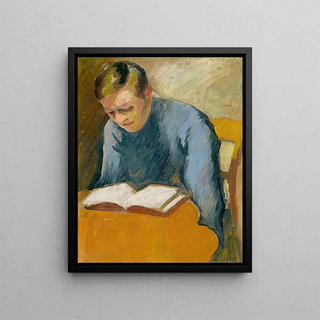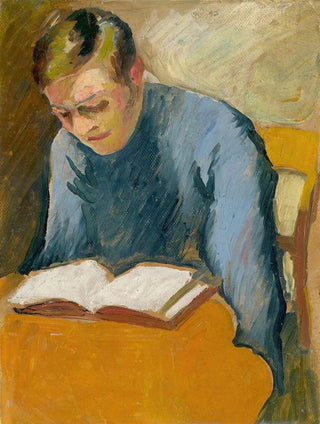Art print | Portrait of Helmuth Macke - August Macke


View from behind

Frame (optional)
In the fascinating world of modern art, some works stand out for their ability to capture not only the physical appearance of a subject but also the very essence of their character. The "Portrait of Helmuth Macke" by August Macke is one of these masterpieces. This painting, created in 1910, reflects an era when art was breaking free from conventions to explore new dimensions of human perception. Delving into this artwork, one discovers a vibrant dialogue between the artist and their model, a connection that transcends mere portraiture to become a true psychological exploration.
Style and uniqueness of the work
August Macke's style is often associated with the expressionist movement, characterized by vivid colors and bold shapes. In the "Portrait of Helmuth Macke," this approach is expressed through a striking palette that immediately draws the eye. The chosen hues are not merely decorative; they evoke deep emotions and create a unique atmosphere. Helmuth's face is rendered with a delicacy that contrasts with the intensity of the surrounding colors, revealing a captivating duality. Every brushstroke seems charged with meaning, inviting the viewer to question identity and subjectivity. This portrait is not limited to a figurative representation; it becomes a space where color and form meet to express the unspeakable.
The artist and their influence
August Macke, a prominent member of the New Objectivity group, left his mark on his era with an innovative approach that influenced many artists of his time and subsequent generations. His work is imbued with a quest for beauty and harmony, often inspired by everyday life and human interactions. In painting portraits, Macke does not merely reproduce faces; he seeks to capture the soul of his subjects. The "Portrait of Helmuth Macke" is emblematic of this pursuit, as it illustrates not only the artist's technical talent but also their commitment to revealing the depth of human relationships through art. His influence endures today, inspiring contemporary artists to explore

Matte finish

View from behind

Frame (optional)
In the fascinating world of modern art, some works stand out for their ability to capture not only the physical appearance of a subject but also the very essence of their character. The "Portrait of Helmuth Macke" by August Macke is one of these masterpieces. This painting, created in 1910, reflects an era when art was breaking free from conventions to explore new dimensions of human perception. Delving into this artwork, one discovers a vibrant dialogue between the artist and their model, a connection that transcends mere portraiture to become a true psychological exploration.
Style and uniqueness of the work
August Macke's style is often associated with the expressionist movement, characterized by vivid colors and bold shapes. In the "Portrait of Helmuth Macke," this approach is expressed through a striking palette that immediately draws the eye. The chosen hues are not merely decorative; they evoke deep emotions and create a unique atmosphere. Helmuth's face is rendered with a delicacy that contrasts with the intensity of the surrounding colors, revealing a captivating duality. Every brushstroke seems charged with meaning, inviting the viewer to question identity and subjectivity. This portrait is not limited to a figurative representation; it becomes a space where color and form meet to express the unspeakable.
The artist and their influence
August Macke, a prominent member of the New Objectivity group, left his mark on his era with an innovative approach that influenced many artists of his time and subsequent generations. His work is imbued with a quest for beauty and harmony, often inspired by everyday life and human interactions. In painting portraits, Macke does not merely reproduce faces; he seeks to capture the soul of his subjects. The "Portrait of Helmuth Macke" is emblematic of this pursuit, as it illustrates not only the artist's technical talent but also their commitment to revealing the depth of human relationships through art. His influence endures today, inspiring contemporary artists to explore






